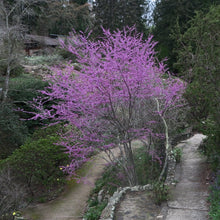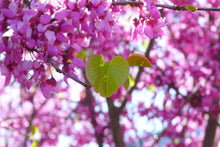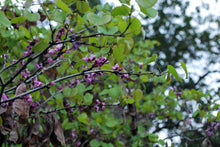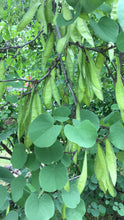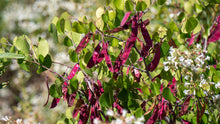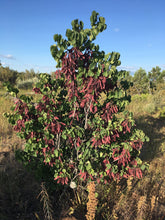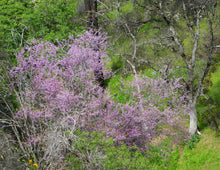
Cercis occidentalis
Western redbud is a deciduous, large shrub or small, multi-stemmed tree with a compact rounded form. It announces the dawning of spring, as early as February, when it becomes blanketed in a sensational display of showy magenta flowers. Its twiggy branches bear delicate heart-shaped leaves that emerge light green but darken as the season progresses. By summer, unique, dark brown seed pods droop heavily on the branches, which are highly nutritious for backyard birds. In cooler climates, the fall color is quite nice.
- Plant type/canopy layer: deciduous, perennial, large shrub or small tree
- Size at maturity: 10-20’ tall, 10-15’ wide
- Light requirements: full sun, part sun/part shade
- Moisture requirements: dry to moist soil
- Bloom time: Feb - April
- Growth rate/ease: medium growth rate, very easy to grow
- Wildlife support: flowers attract and support hummingbirds, adult butterflies and bees and other insect pollinators; seed pods attract and provide nutrient-rich food for birds; overall plant supports beneficial and pest-eating insects;
- Native habitat/range: found in canyons, slopes, foothills and mountains of southern Oregon (rare/Siskiyous), predominantly in California, as well as Utah and Arizona. In northern/wetter areas, it's more common on dry slopes whereas in the southern/drier areas it’s near higher elevation creeks and more moist areas. Portland Plant List - no.
- Special features & uses: attracts hummingbirds, song birds and pollinators; deer resistant; fascinating late season color; landscape uses include bank stabilization, pollinator gardens, and woodland gardens
Gardening with Western Redbud: This gorgeous landscape plant is not historically native to our area, but does have occurrences in southern Oregon. So as the climate shifts, it's an exciting and highly-versatile species to consider adding to the habitat garden. It will thrive in mostly sunny sites with well-drained soil, but ultimately it adapts to a wide range of soil moisture and drainage, including alkaline, acidic and sodic soils - as well as exceptional drought-tolerance. It responds well to pruning, even occasional hard pruning if needed or desired. Consider placing this in your oakscape areas, along with pacific madrone (Arbutus menziesii), Ceanothus species; coast silktassel (Garrya elliptica), mock orange (Philadelphus lewisii), blue elderberry (Sambucus nigra), birchleaf spiraea (Spiraea betulifolia var. lucida), foothill sedge (Carex tumulicola), fringecup (Tellima grandiflora), Oregon sunshine (Eriophyllum lanatum) or checkermallows (Sidalcea sp.)
Photo Credit 1: "J20160303-0099—Cercis occidentalis—RPBG" by John Rusk is licensed under CC BY 2.0.
Photo Credit 2: "California Redbud (Cercis occidentalis)" by StephanieFalzone is licensed under CC BY 2.0.
Photo Credit 3: "Cercis occidentalis" by briweldon is licensed under CC BY 2.0.
Photo Credit 4: "Cercis occidentalis" by Katie McCoy is licensed under CC BY 4.0.
Photo Credit 5: "Cercis occidentalis" by mdhancher is licensed under CC BY 4.0.
Photo Credit 6: "Cercis occidentalis" by Matt Berger is licensed under CC BY 4.0.
Photo Credit 7: "Cercis occidentalis" by Mary K. Hanson is licensed under CC BY 4.0.







